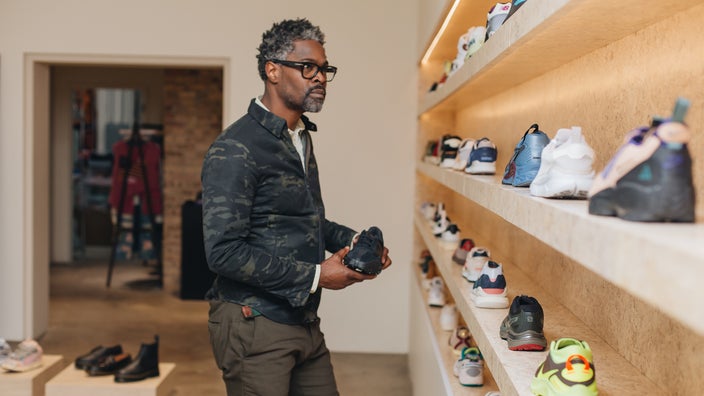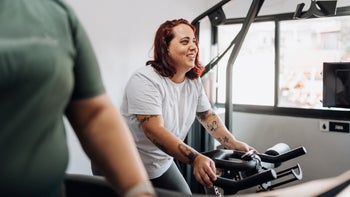
How Often Should You Replace Your Running Shoes?
Key takeaways:
Most running shoes last between 300 to 500 miles or 6 months.
Worn-out running shoes don’t have the support you need for safe, effective runs.
Rotating between two pairs of running shoes and only wearing them while you run can extend the life of your shoes.

One of the best things about running is that it requires very little equipment. All you need is a good pair of shoes and comfortable clothes to get started. The right running shoes –– which should have adequate cushioning to absorb shock –– can help make your runs efficient and injury-free.
But running shoes inevitably break down over time. When this happens, it's critical to swap out worn-out shoes that no longer provide the support you need. But how do you know when it's time to replace your running shoes? Expert guidelines and tips can help you decide when to toss your shoes.
When should you replace your running shoes?
Most experts recommend replacing your running shoes every 300 to 500 miles or every 6 months — whichever comes first. If you're an advanced, high-mileage runner, you will likely hit 300 to 500 miles before the 6-month mark. New or occasional runners might not hit that target in 6 months. But you should still plan to replace your running shoes around twice a year.
Search and compare options
The swap is important because running shoe materials –– like mesh and foam –– have a shelf life. Wear and tear from high-impact activities like running break down those materials over time.
Expert recommendations can serve as a guide. But keep in mind that several factors can affect how long your running shoes last, including:
The style, material, and construction of your shoes
Your running gait or form, including footstrike pattern
Your foot structure, including arch and pronation
Climate and running surface
For example, if your feet roll inward when you run (overpronation), you put more strain on the arches and heels of your feet. The inner heels of your shoes may break down quicker as a result. Running on hard surfaces can also shorten the life of your shoes. So outdoor runners might need new shoes sooner than treadmill runners.
Use your judgment and replace your running shoes when your current pair no longer provides the support you need.
Can worn-out shoes hurt your feet?
The wrong running shoes or old running shoes don’t necessarily cause running injuries. But worn-out shoes can contribute to an injury.
Read more like this
Explore these related articles, suggested for readers like you.
Worn-out running shoes do not provide the same amount of cushioning necessary to absorb impact shock. The foam materials break down and do not rebound as quickly or effectively as you run. Old running shoes also may not support your foot properly. This can cause pain in the arches or lead to other foot and leg injuries.
Runners who have flat feet or who overpronate should be especially careful about replacing worn running shoes right away. These issues require running shoes with more support.
How do you know if your running shoes are worn out?
These signs of wear and tear can help you know when it's time for a new pair of shoes.
You have new aches and pains
If you have new pain in your legs –– including your knees, shins, ankles, and feet –– your shoes might be worn out. Those aches and pains may be from insufficient cushioning.
You feel more impact while running
New running shoes have a springy feel to them. That's because foam cushioning absorbs shock and helps you rebound after every step. When that material deteriorates, so does the bounciness. That can make it harder to keep going because you might feel more lower-body impact with each step.
You notice worn-out treads or uneven wear patterns
Keep an eye on the wear patterns on the bottom of your shoes. Uneven wear can tell you more about how you run and when it's time to buy new shoes. For example, if your feet roll outward when you run (underpronation), you put more strain on the outer edges of your feet. So you might notice more damage along the outside edges of your shoes.
The treads on the bottom of your running shoes have a unique pattern that provides traction to keep you on your feet. Eventually, the treads wear down, making your runs less efficient.
Your midsole is softer and less supportive
The midsole of your running shoes has supportive elements that help keep your feet, especially the arch, properly aligned. If these materials get too soft and your midsoles are less firm, your arches can collapse upon impact. This means your running shoes are no longer providing the necessary support.
Tips to make your running shoes last longer
It's tough to part with your favorite running shoes. And even though they will wear out eventually, there are some things you can do to extend their life.
Find the right running shoes for you. Every runner has their own definition of what makes a great running shoe. Look for a pair that fits properly, feels comfortable, and supports your feet.
Save your running shoes for running only. It might be convenient to wear your go-to running shoes all day. But doing so can make them wear down quicker. So make sure you only wear your running shoes while running.
Untie your laces before you take off your running shoes. Resist the urge to slip off your running shoes without untying the laces. Slipping them off like this can damage the back of the heel, which provides rearfoot stability.
Let your shoes air-dry indoors after each run. If your shoes get wet, stuff them with newspapers or shoe dryers to absorb excess moisture. Don't throw them in the dryer or leave them outside to dry after your runs. Both these practices can make your running shoes break down faster.
Rotate between two pairs of running shoes. Give your running shoes a break by switching between two pairs, and avoid wearing the same pair two days in a row. This strategy can help both pairs of running shoes last longer.
The bottom line
Supportive running shoes absorb shock to help you run comfortably and efficiently. But even the best pair will eventually have to be replaced. Most running shoes last between 300 and 500 miles, or 6 months, depending on which comes first. Get the most out of your running shoes by wearing them only while running, keeping them dry, and rotating between two pairs.
Why trust our experts?



References
Fu, W., et al. (2015). Surface effects on in-shoe plantar pressure and tibial impact during running. Journal of Sport and Health Science.
Goldberg, D. A., et al. (1983). Heel counter stabilization of the running shoe. The Journal of Orthopaedic and Sports Physical Therapy.
Long, A. (2015). Are you wearing the right shoes for your workout? American Council on Exercise.
Malisoux, L., et al. (2020). Can the ‘appropriate’ footwear prevent injury in leisure-time running? Evidence versus beliefs. Journal of Athletic Training.
Nigg, B. M., et al. (2015). Running shoes and running injuries: Mythbusting and a proposal for two new paradigms: 'Preferred movement path' and 'comfort filter'. British Journal of Sports Medicine.
Nilsson, J., et al. (1989). Ground reaction forces at different speeds of human walking and running. Acta Physiologica Scandinavica.
OrthoInfo. (2014). Walking and pronation.
Sun, X., et al. (2020). Systematic review of the role of footwear constructions in running biomechanics: Implications for running-related injury and performance. Journal of Sports Science & Medicine.




























